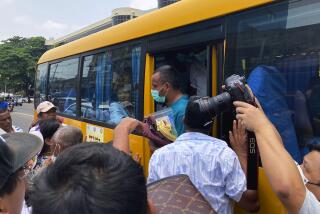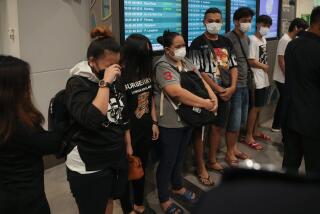Most Vietnamese Army Deserters Marooned in Thai Refugee Camps
PHANAT NIKHOM, Thailand â An estimated 500 to 600 Vietnamese army deserters languish in Thai refugee camps, largely forgotten and unwanted.
Thailand doesnât want them to stay. Vietnam wonât take them back, even if they wanted to go back. Western countries, including the United States, for the most part refuse to resettle them as refugees, even though they maintain that they are victims of Vietnamâs Communist system.
The deserters are men who were sent to fight guerrillas opposing the Vietnamese-backed government in Cambodia.
Most are at the refugee camp here in Phanat Nikhom, near Bangkok, where about 430 live together in ramshackle bamboo and canvas huts, isolated from other Vietnamese who fear them as part of the Communist government they fled.
This rejection and the trauma of the war and their flight have created what one Western relief worker called a âhopeless, helpless, lost subculture.â
In a camp where most refugees are preparing for new lives in the West, many deserters have remained for years, deep in depression. Some have attempted suicide, officials said. Still others have turned to drugs and violence.
Vietnam invaded Cambodia in late 1978 and now has about 125,000 troops fighting 50,000 or more guerrillas.
Desertions on the Decline
More than 1,000 Vietnamese soldiers have fled to Thailand since 1981, according to Thai officials, but desertions have decreased in recent years, probably because the fighting no longer is near the Thai-Cambodian border, which made it easy for soldiers to desert.
Some 300 deserters arrived in Phanat Nikhom in 1985, when thousands of Vietnamese troops overran guerrilla bases near the border, but only 80 came in 1987, and just two have come so far this year.
The deserters, usually single males with few skills or ties abroad, are among the most difficult refugees in Thailand to resettle.
Canada has taken the most--nearly 150 since 1981.
Two-thirds of the 76 deserters resettled last year were taken by Scandinavian nations, which traditionally accept difficult cases.
The United States, by far the biggest resettler of Indochinese overall, has taken only about 100, largely because it considers the deserters part of an occupying army that persecuted others.
Political Considerations
Some aid officials criticize the refusal to accept more deserters as being based on political, not humanitarian, considerations.
âPeople donât think of us as people who escaped the army of the Communists,â complained Hoang Manh Chuong, a 27-year-old deserter who has been here since 1984 and was rejected by the United States in January. âThey think we are still bad people.â
Chuong said he fled while on guard duty in August, 1983, a month after arriving in western Cambodia. He wandered into the jungle for five days with nothing to eat, following the sunset to the Thai border, he said. He added that Khmer Rouge guerrillas held him captive for two months and beat him as a suspected spy. He was then jailed in Aranyaprathet in Thailand for 10 months before reaching Phanat Nikhom.
Like several others interviewed, Chuong said he deserted because the Communists persecuted his family after 1975. He said his father, a former South Vietnam soldier, was held in political âre-educationâ camps for six years.
Chuong said Vietnamese who flee to Thailand as boat people and get more favored treatment as refugees are rich people who can afford to pay for boat passage. The deserters, he added, are poor.
Chuong said he continues to study English in hope of getting to the United States, but he added that many other deserters are âtoo angry . . . and donât care any more.â They get drunk and wind up in the camp jail, he said.
Another deserter, Le Truong Truc, 29, became addicted to heroin.
More to Read
Sign up for Essential California
The most important California stories and recommendations in your inbox every morning.
You may occasionally receive promotional content from the Los Angeles Times.










